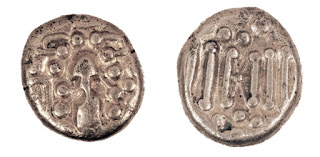The Chaulukya dynasty ruled parts of present-day Gujarat and Rajasthan in north-western India, between 940 AD and 1244 AD.
Coin of Chaulukyas of Gujarat, 11th Century AD, Indo-Sassanian style bust right, pellets and ornaments around.
Their capital was located at Anahilavada (modern Patan). At times their rule extended to the Malwa region in present day Madhya Pradesh. The family is also known as the Solanki dynasty. The Chaulukyas were one of the dynasties that rose to power amid the decline of the Gurjara-Pratihara and the Rashtrakuta empires.
Mularaja, the founder of the dynasty, supplanted the first ruler of the Chavda dynasty around 940 AD.
The word ''Chaulukya'' is a variant of the word ''Chalukya''. Several other dynasties were known by the name ''Chalukya'', including Chalukyas of Vatapi, Navasarika, Vemulavada, Kalyani, Vengi and Lata. These dynasties are sometimes thought to be branches of the same family. Chaulukyas of Gujarat never claimed a shared descent or any association with the earliest Chalukya dynasty.
The Chaulukya rulers have been called ''Gurjaraja'' and ''Gurjaresvara''. Mularaja was succeeded by his son Chamundaraja around 996 AD. Twelve rulers ruled between 940 to 1244 AD.
Maru-Gurjara architecture, or ''Solanki style'' is a style of north Indian temple architecture that originated from the 11th to 13th centuries. It became very popular in Jain temples and later spread across India to diaspora communities around the world.
Most of the dynasty's rulers were Shaivaite, although they also patronized Jainism.
In 1024-1025 AD, the Turkic Muslim ruler Mahmud of Ghazni raided Gujarat and plundered the Somnath temple under the rule of Bhima I, who later formed an alliance with neighbouring rulers.
Somnath Temple in 1869
Jayasimha Siddharaja (1092-1142 AD) greatly expanded the Chaulukya power. His daughter married his ally Arnoraja of Chahamana. The couple's son Someshvara, was brought up at the Chaulukya court. Someshvara's son Prithviraj III (better known as Prithviraj Chauhan) was also born in Gujarat.
Kumarapala ascended the throne in 1043 AD. Historical evidence suggests that his empire extended from Chittor and Jaisalmer in the north to the Vindhyas and the Tapti River in the south. In the west it included Kachchha and Saurashtra. In the east, it extended upto Vidisha.
After Kumarapala's death, the kingdom gradually weakened by internal rebellions, uprising by feudatories and invasions by other rulers.
During the rule of Bhima II, (1178-1240 AD) some provincial governors rebelled against him in order to establish independent states. A number of other rulers like the Yadavas and Hoysala attacked Gujarat.
In the 1240's AD, the Vaghelas, who had earlier served as Chauluka generals, usurped the power and established a new dynasty in the 1240's. Several princely state rulers of the Solanki clan claimed descent from the Chaulukyas.
Obverse: Indo-Sasanian style bust right, sun and moon above
Reverse: Stylized fire altar, sun (rosette of dots) above left crescent moon above right
Obverse: Indo-Sasanian style bust right, sun and moon above
Reverse: Stylized fire altar, sun (rosette of dots) above left crescent moon above right
Chaulukyas of Gujarat, drachm (gadhaiya paisa), 11th century AD, weight 4.22 g
Obverse: Indo-Sasanian style bust right, sun and moon above
Reverse: Stylized fire altar, sun (rosette of dots) above left crescent moon above right
Obverse: Elephant walking right with a trunk touching the ground
Obverse: Elephant walking right, dotted border
Reverse: Nagari legend in two lines, ''Sri Rana / Hasti, meaning elephant
Chaulukyas of Gujarat, drachm (Gadhiya paisa), 11th century AD, weight 4.2 g
Obverse: Indo-Sasanian style bust right, sun and moon above
Reverse: Stylized fire altar, sun (rosette of dots) above left crescent moon above right
Hasti Dramma, Siddaraja Jaysimha, (1094-1144 AD), Drachm, silver, weight 0.43 g
Obverse: Elephant walking right
Reverse: Nagari legend Srima Jaya Simha in two lines
Chaulukyas of Gujarat, drachm (Gadhiya paisa), 1120-1210 AD, weight 4.2 g
Obverse: Indo-Sasanian style bust right, sun and moon above
Reverse: Stylized fire altar, sun (rosette of dots) above left crescent moon above right
















No comments:
Post a Comment
Any inputs or feedback is welcome!